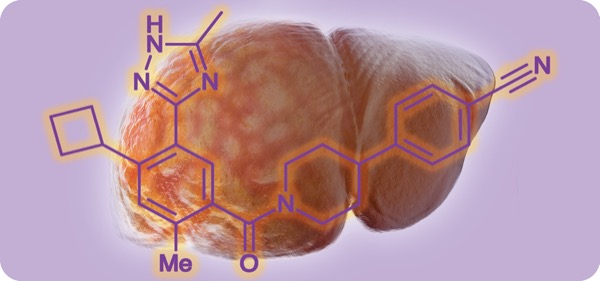The inhibition of fatty acid synthase inhibition may hold promise as a therapy for patients with nonalcoholic steatohepatitis, researchers have found.
A multicenter team of investigators concluded that the fatty acid synthase inhibitor TVB-2640 (Sagimet Biosciences) significantly reduced liver fat, serum biomarkers of liver injury, fibrosis and inflammation in a cohort of patients with NASH.
“We have noticed in the past that if you block de novo lipogenesis and activate beta oxidation in the liver, you can improve steatohepatitis,” lead author Rohit Loomba, MD, the director of the NAFLD Research Center and director of hepatology at the University of California, San Diego, said. “So, we hypothesized that treatment with a fatty acid synthase inhibitor could block de novo lipogenesis, thereby reducing the biomarkers associated with liver inflammation and liver fibrosis.”
In the phase 2 trial, Loomba and his colleagues assessed the safety and efficacy of TVB-2640—an oral, once-daily, first-in-class small-molecule fatty acid synthase inhibitor—in 99 men and women in the United States. Patients were included in the study if they demonstrated liver fat content by MRI (proton density fat fraction [PDFF] =8%) and evidence of liver fibrosis (magnetic resonance elastography =2.5 kPa or liver biopsy F1-F3). The participants, who had a mean baseline PDFF of 16.7%, were randomized to receive once-daily doses of TVB-2640 at either 25 or 50 mg or placebo for 12 weeks.
Responders were defined as those who achieved a reduction in liver fat of at least 30% by week 12. The trial’s primary end points were changes in liver fat by MRI-PDFF and safety. Additional end points were the impact of TVB-2640 on alanine aminotransferase (ALT), cholesterol, triglycerides, lipoproteins, lipidomics and liver fibrosis markers.
In a presentation at the 2020 digital Liver Meeting (abstract 67), Loomba reported that the results showed a clear dose-dependent relationship between TVB-2640 dose and reductions in liver fat. Patients who received the 25-mg dose of the drug experienced a mean reduction in liver fat of 9.6% (P=0.053 relative to placebo). The decrease was 28.2%, on average, for patients who received the 50-mg dose (P=0.001). Patients on placebo saw their liver fat increase by a mean of 4.5% over the study period, Loomba’s group reported.
The researchers observed similar relationships with other markers of liver fat. PDFF response rates associated with TVB-2640 were 23% at 25 mg and 61% at 50 mg (P=0.001), compared with 11% for placebo. Levels of ALT fell in both TVB-2640 groups, although patients in the 50-mg cohort achieved the greatest reduction, at 20.4% (P=0.001), the researchers reported. Levels of low-density lipoprotein (LDL) also fell in the 50-mg cohort, by 7% relative to placebo.
“In addition to improving ALT, TVB-2640 also improved LDL cholesterol, albeit just by a small amount,” Loomba told Gastroenterology & Endoscopy News. “So it seems to be cardiovascularly beneficial, which is important in NASH since cardiovascular disease is the greatest cause of mortality.”
Analysis of serum markers of fibrosis and inflammation demonstrated improvements among patients treated with the larger dose of TVB-2640. The investigators also measured serum tripalmitin, a marker of de novo lipogenesis, which decreased in patients treated with TVB-2640 compared with placebo. This effect, Loomba said, confirms inhibition of fatty acid synthase.
Adverse events associated with TVB-2640 were largely mild (primarily grade 1), and no serious adverse events occurred, Loomba said, including no evidence of biochemical or hematologic toxicity.
“Typically, some of the other drugs that lower liver fat by lipogenesis inhibition, such as acetyl-CoA carboxylase inhibitors, can increase serum triglyceride levels,” Loomba explained. “But this drug did not, which I think is helpful.”
Given the findings, the researchers plan on moving to phase 2b trials sometime in 2021, he added.
Michelle T. Long, MD, MSc, an assistant professor of medicine at Boston University School of Medicine, said the new study “covers an area of critical need. As cardiometabolic disease remains the leading cause of death in patients with NAFLD [nonalcoholic fatty liver disease], it is important that therapies that target hepatic end points also do not worsen—and hopefully improve—cardiovascular disease.”
Although the experimental agent appeared to be well tolerated, additional studies are needed to demonstrate safety for patients with NAFLD, who are most often asymptomatic from liver disease, Long said. “Also, questions remain as to the treatment duration, and it isn’t known what happens to the hepatic fat and fibrosis measures after study drug is withdrawn,” she said.
—Michael Vlessides
Loomba reported financial relationships with 89bio, AstraZeneca, Eli Lilly and Co., Gilead, Glympse Bio, Intercept, Inventiva, Ionis, Janssen, Madrigal, Merck & Co., Metacrine, NGM Bio, Novartis, Novo Nordisk, Pfizer, Sagimet Biosciences and Viking. Long reported financial relationships with Echosens, Gilead and Ionis.
This article is from the May 2021 print issue.


